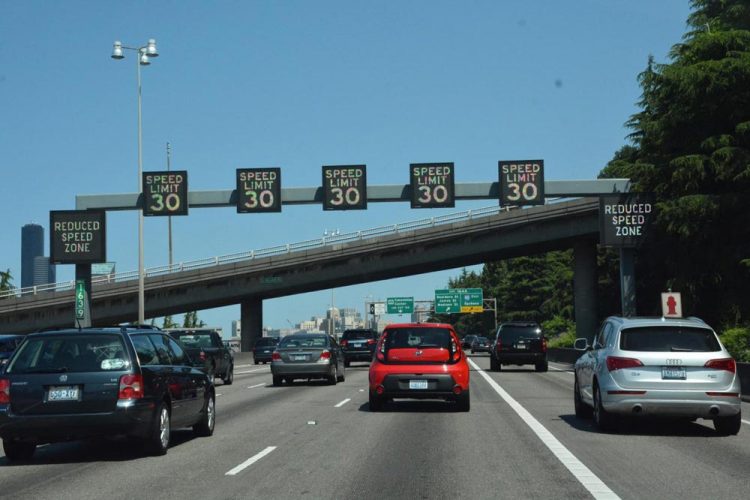Variable speed limits could reduce crashes, ease congestion in highway work zones

Praveen Edara found that using variable speed limits similar to this one in construction zones may ease congestion, reduce crashes and make work zones safer for both workers and travelers nationally. Credit: Steve Schar
Researchers at the University of Missouri have studied systems to alleviate inevitable backups and delays. Researchers found that using variable speed limits in construction zones may ease congestion, reduce crashes and make work zones safer for both workers and travelers nationally.
With assistance from the Missouri Department of Transportation, Praveen Edara, associate professor of civil and environmental engineering in the MU College of Engineering, tested the use of variable advisory speed limit (VASL) systems and the effect they may have on lessening congestion and reducing rear-end and lane-changing accidents on a fairly dangerous stretch of I-270, a major four-lane highway in St. Louis.
“The idea was to see if warning drivers of slower speeds ahead helped reduce crashes,” Edara said. “Where there is queueing, if drivers are not aware of the queue downstream, they don't have enough time to hit the brakes to slow down or stop, thus, increasing the likelihood of a crash. Instead of posting a message asking them to slow down, the VASL system posts an advisory speed limit based on the actual downstream traffic speed, so drivers would know that if they're driving 50 mph, they should slow to 30 mph downstream.”
Edara's data collection and simulation analysis uncovered a few key pieces of data. First, the use of VASL systems is effective in gradually slowing drivers as they enter work zones. VASL use resulted in a 39 to 53 percent decrease in average queue length, and just a 4 to 8 percent increase in travel time.
Additionally, using VASL meant that maximum speed differences also decreased by as much as 10 mph, and the chance of rear-end collisions dropped by 30 percent. Researchers also noted a 20 percent decrease in lane changing conflicts. Essentially, travel time was slightly longer, but lines were shorter and collisions were less frequent.
“You can get both safety benefits and mobility benefits by deploying variable advisory speed limit systems in work zones,” Edara said.
“Evaluation of variable advisory speed limits in congested work zones” recently was published in the Journal of Transportation Safety and Security. Carlos Sun, an MU professor of civil and environmental engineering, and Yi Hou a doctoral student at Mizzou, co-authored the study.
Media Contact
All latest news from the category: Transportation and Logistics
This field deals with all spatial and time-related activities involved in bridging the gap between goods and people, including their restructuring. This begins with the supplier and follows each stage of the operational value chain to product delivery and concludes with product disposal and recycling.
innovations-report provides informative reports and articles on such topics as traffic telematics, toll collection, traffic management systems, route planning, high-speed rail (Transrapid), traffic infrastructures, air safety, transport technologies, transport logistics, production logistics and mobility.
Newest articles

NASA: Mystery of life’s handedness deepens
The mystery of why life uses molecules with specific orientations has deepened with a NASA-funded discovery that RNA — a key molecule thought to have potentially held the instructions for…

What are the effects of historic lithium mining on water quality?
Study reveals low levels of common contaminants but high levels of other elements in waters associated with an abandoned lithium mine. Lithium ore and mining waste from a historic lithium…

Quantum-inspired design boosts efficiency of heat-to-electricity conversion
Rice engineers take unconventional route to improving thermophotovoltaic systems. Researchers at Rice University have found a new way to improve a key element of thermophotovoltaic (TPV) systems, which convert heat…



